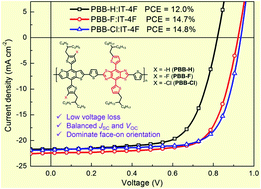High-efficiency organic solar cells enabled by halogenation of polymers based on 2D conjugated benzobis(thiazole)†
Abstract
With the rapid development of non-fullerene acceptors, polymer donor design is critical for the realization of significantly higher power conversion efficiencies in organic solar cells (OSCs). The donor–acceptor (D–A) alternating structure is an effective strategy for the design of polymers due to its advantages in optical absorption, energy level modulation, charge mobilities, etc. Nevertheless, the current development of polymers is restricted in terms of modification of the acceptor unit. In this work, a 2D conjugated acceptor unit of benzobis(thiazole) was designed for constructing wide bandgap polymers. Fluorine and chlorine atoms were introduced into the polymers to modulate the energy levels and film morphology. The photovoltaic performances of the polymers were examined by fabricating devices employing IT-4F as the acceptor. All three polymers exhibit high short-circuit densities (JSCs) of over 21 mA cm−2 in the devices which could be attributed to high extinction coefficient and beneficial face-on orientation, as featured by the polymers based on the 2D conjugated BBT unit. Incorporation of F- or Cl-atoms effectively improved all three photovoltaic parameters open-circuit voltage (VOC), JSC and fill factor. As a result, a high power conversion efficiency of 14.8% was achieved for the chlorinated polymer (PBB-Cl). A high VOC of 0.94 V and JSC of 21.8 mA cm−2 were realized in the devices, indicating well-balanced VOC and JSC values. Dominant face-on orientation was observed for all three polymer films, which is beneficial for charge transport in the vertical direction of the substrate. Given the excellent photovoltaic performance achieved in the devices, the polymer based on the 2D conjugated BBT unit would be a very promising candidate for high performance organic solar cells.



 Please wait while we load your content...
Please wait while we load your content...